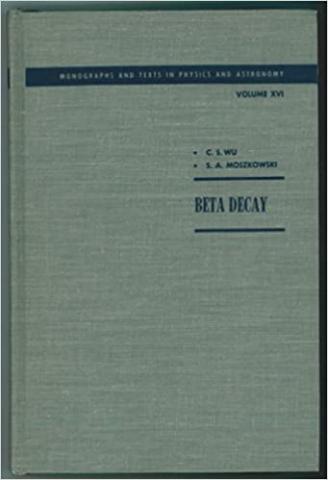Beta Decay

The realization that parity is not conserved in beta decay has greatly stimulated interest in the whole field of elementary particle physics. The recently report discovery of two kinds of neutrinos and the successful venturing into the high-energy neutrino field will undoubtedly gratly accelerate our inquiries into the intrinsic nature of weak interactions. We now have strong evidence that beta decay is only one of the many branches of the universal Fermi interaction, but it is the one that has been most closely studied and is best understood.
The amazing progress in this area has been due both to evidence provided by experimental observations and to theoretical attempts to interpret the observations. We shall try to understand the phenomena of beta decay in both its experimental and theoretical aspects. This book covers the main features of beta decay and, for completeness, includes the essential feature of other weak interactions with leptonic decays.
Evidence for V—A Interaction. Suddenly many doors swung open to lead to the determination of the β interactions.
β-ν Angular Correlations. Before the discovery of parity non conservation in β decay, the AT combination had been the favorite choice based mostly on He6 β-ν angular-correlation results. In fact, the β-ν angular correlation was the only means used to investigate the type of β interactions in those days. But this type of experiment was known to be difficult. Wu and Schwarzschild made a detailed examination of the old He6 experiment and pointed out that the effective volume of the He6 source in the hole of the pumping diaphragm was not correctly taken into account. Had this been done properly, the result of He6 would not have implied the tensor interaction.
However, in spite of its many limitations, the β-ν correlation is still and effective and powerful method for yielding information of the β interaction. The first sign of warning against the ST combination the β interaction came in May of 1957 when Allen and his co-workers at the University of Illinois published their β-ν correlation results on A35, which decays mainly via the Fermi interaction. The results strongly supported the V interaction instead of S, as was once believed. Later, this group remeasure the β-ν correlation in He6 with the same apparatus they used in the investigation of A35 at Argonne National Laboratory. The result favors A in He6. Thus the VA combination is strongly favored from β-ν correlation experiments.
The early experimental results indicated that a is close to +1/3, favoring a tensor interaction. However, more recent experiments (He-58; Al-59), whose arrangements are shown prove inclusively that coefficient a in Gamow-Teller is negative, being in fact close to the expected value of -1/3 for the axial-vector form. This result has been confirmed by the Oak Ridge group (Jo-63) with a more refined setup